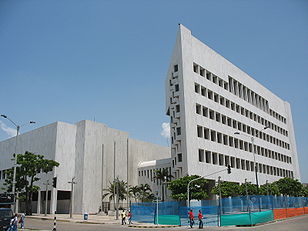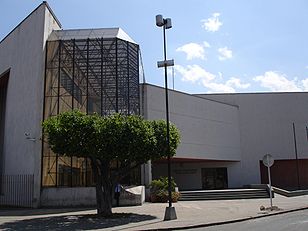.gif)
Bank of the Republic (Colombia)
Encyclopedia


Central bank
A central bank, reserve bank, or monetary authority is a public institution that usually issues the currency, regulates the money supply, and controls the interest rates in a country. Central banks often also oversee the commercial banking system of their respective countries...
of the Republic of Colombia
Colombia
Colombia, officially the Republic of Colombia , is a unitary constitutional republic comprising thirty-two departments. The country is located in northwestern South America, bordered to the east by Venezuela and Brazil; to the south by Ecuador and Peru; to the north by the Caribbean Sea; to the...
. Its main functions are detailed by the Congress
Congress of Colombia
The Congress of the Republic of Colombia is the name given to Colombia's bicameral national legislature.The Congress of Colombia consists of the 102-seat Senate , and the 166-seat Chamber of Representatives ...
according to the Ley 31 de 1992. One of them is the issuance of the Colombian currency, the peso
Colombian peso
The peso is the currency of Colombia. Its ISO 4217 code is COP and it is also informally abbreviated as COL$. However, the official peso symbol is $. As 20 July 2011, the exchange rate of the Colombian peso is 1750 Colombian pesos to 1 U.S. dollar.-History:The peso has been the currency of Colombia...
.
History
There are at least three predecessors to the current bank. The first national bankNational bank
In banking, the term national bank carries several meanings:* especially in developing countries, a bank owned by the state* an ordinary private bank which operates nationally...
was created in 1880, named the Banco Nacional, and its functions included handling the state funds, issuing currency and making loans to the state. In 1894 the Congress closed the bank due to registered excesses in the issuance of currency. In 1905, the Banco Central de Colombia was created but it was closed in 1909 for identical reasons.
In 1923, after several years of financial crisis, President Pedro Nel Ospina
Pedro Nel Ospina
Pedro Nel Ospina Vázquez was a Colombian general and political figure. He served as president of Colombia between 1922 and 1926.- Biography:...
requested an expert committee to study Colombian economic conditions. This committee, led by American economist Edwin Walter Kemmerer (known as The Money Doctor) was called the Mission Kemmerer. Kemmerer had already worked with Latin American governments: that of Mexico
Mexico
The United Mexican States , commonly known as Mexico , is a federal constitutional republic in North America. It is bordered on the north by the United States; on the south and west by the Pacific Ocean; on the southeast by Guatemala, Belize, and the Caribbean Sea; and on the east by the Gulf of...
in 1917 and of Guatemala
Guatemala
Guatemala is a country in Central America bordered by Mexico to the north and west, the Pacific Ocean to the southwest, Belize to the northeast, the Caribbean to the east, and Honduras and El Salvador to the southeast...
in 1919. He helped the Colombian government create the Bank of the Republic and the Office of the Comptroller General of the Republic, and to structure the laws for this function using those already existing. After his work in Colombia, Kemmerer did the same for other Latin American governments, like Chile
Chile
Chile ,officially the Republic of Chile , is a country in South America occupying a long, narrow coastal strip between the Andes mountains to the east and the Pacific Ocean to the west. It borders Peru to the north, Bolivia to the northeast, Argentina to the east, and the Drake Passage in the far...
in 1925, Ecuador
Ecuador
Ecuador , officially the Republic of Ecuador is a representative democratic republic in South America, bordered by Colombia on the north, Peru on the east and south, and by the Pacific Ocean to the west. It is one of only two countries in South America, along with Chile, that do not have a border...
in 1926 and Peru
Peru
Peru , officially the Republic of Peru , is a country in western South America. It is bordered on the north by Ecuador and Colombia, on the east by Brazil, on the southeast by Bolivia, on the south by Chile, and on the west by the Pacific Ocean....
in 1931.
The bank was officially created by the Law 25 of July 25, 1923, 5 days after the 113 anniversary of the Independence of Colombia. With a capital of 10 million dollars in gold, half provided by the government and the rest by foreign and national commercial banks. Its role as a banker for banks includes:
- Acting as a State Bank
- Controlling the issue of the currency, the Colombian pesoColombian pesoThe peso is the currency of Colombia. Its ISO 4217 code is COP and it is also informally abbreviated as COL$. However, the official peso symbol is $. As 20 July 2011, the exchange rate of the Colombian peso is 1750 Colombian pesos to 1 U.S. dollar.-History:The peso has been the currency of Colombia...
- Receiving foreign credits and make loans to the Government and private banks
- Managing the financial policy of the country
- Regulating the exchange rateExchange rateIn finance, an exchange rate between two currencies is the rate at which one currency will be exchanged for another. It is also regarded as the value of one country’s currency in terms of another currency...
between the peso and other currencies
The Board of Directors was created by the same law, with ten members from private and public sectors of the economy with the power to enforce regulatory and monetary controls. The Board was also given the responsibility of establishing the discount rate
Discount rate
The discount rate can mean*an interest rate a central bank charges depository institutions that borrow reserves from it, for example for the use of the Federal Reserve's discount window....
and intervening to control interest rates.
Building
The headquarters of the Bank of the Republic are located in BogotáBogotá
Bogotá, Distrito Capital , from 1991 to 2000 called Santa Fé de Bogotá, is the capital, and largest city, of Colombia. It is also designated by the national constitution as the capital of the department of Cundinamarca, even though the city of Bogotá now comprises an independent Capital district...
, in the historical center of the city (Calle 11 No. 4-21) and a few blocks away from the Gold Museum
Gold Museum
The Gold Museum is a museum located in Bogotá, Colombia. It displays an extraordinary selection of its pre-Hispanic gold work collection - the biggest in the world - in its exhibition rooms on the second and third floors...
and the Luis Ángel Arango Library
Luís Ángel Arango Library
Luis Ángel Arango Library, is a public library located in Bogotá, Colombia. It was founded in 1923 as a small library with a few books on economics. It is currently under the administration of the Bank of the Republic...
. Along with the Fiscalía General de la Nación de Colombia bunker, it is one of the most secure buildings in the country, with several security levels required to access different areas. The security is handled by private companies and the Colombian National Police
Colombian National Police
The National Police of Colombia is the national police force of Colombia. Although the National Police is not part of the Military of Colombia , it constitutes along with them the "Public Force" and is also controlled by the Ministry of Defense. They are the largest police force in Colombia...
, armed with Colombian-made MAC-10
MAC-10
The MAC-10 is a highly compact, blowback operated machine pistol developed by Gordon B. Ingram in 1964.-Design:The M-10 was built predominantly from steel stampings...
sub-machine guns, among others. Most of the administrative areas of the bank are located above ground, in a twelve-story building. Below the street there is a heavily-guarded area where money in different currencies is stored, and in a special vault the country's reserve of gold
Gold
Gold is a chemical element with the symbol Au and an atomic number of 79. Gold is a dense, soft, shiny, malleable and ductile metal. Pure gold has a bright yellow color and luster traditionally considered attractive, which it maintains without oxidizing in air or water. Chemically, gold is a...
.
Culture
Beside their primary roles in the Colombian economy, the Bank of The Republic has control over two important institutions in Colombian culture: the Gold MuseumGold Museum
The Gold Museum is a museum located in Bogotá, Colombia. It displays an extraordinary selection of its pre-Hispanic gold work collection - the biggest in the world - in its exhibition rooms on the second and third floors...
and the Luis Ángel Arango Library
Luís Ángel Arango Library
Luis Ángel Arango Library, is a public library located in Bogotá, Colombia. It was founded in 1923 as a small library with a few books on economics. It is currently under the administration of the Bank of the Republic...
.

